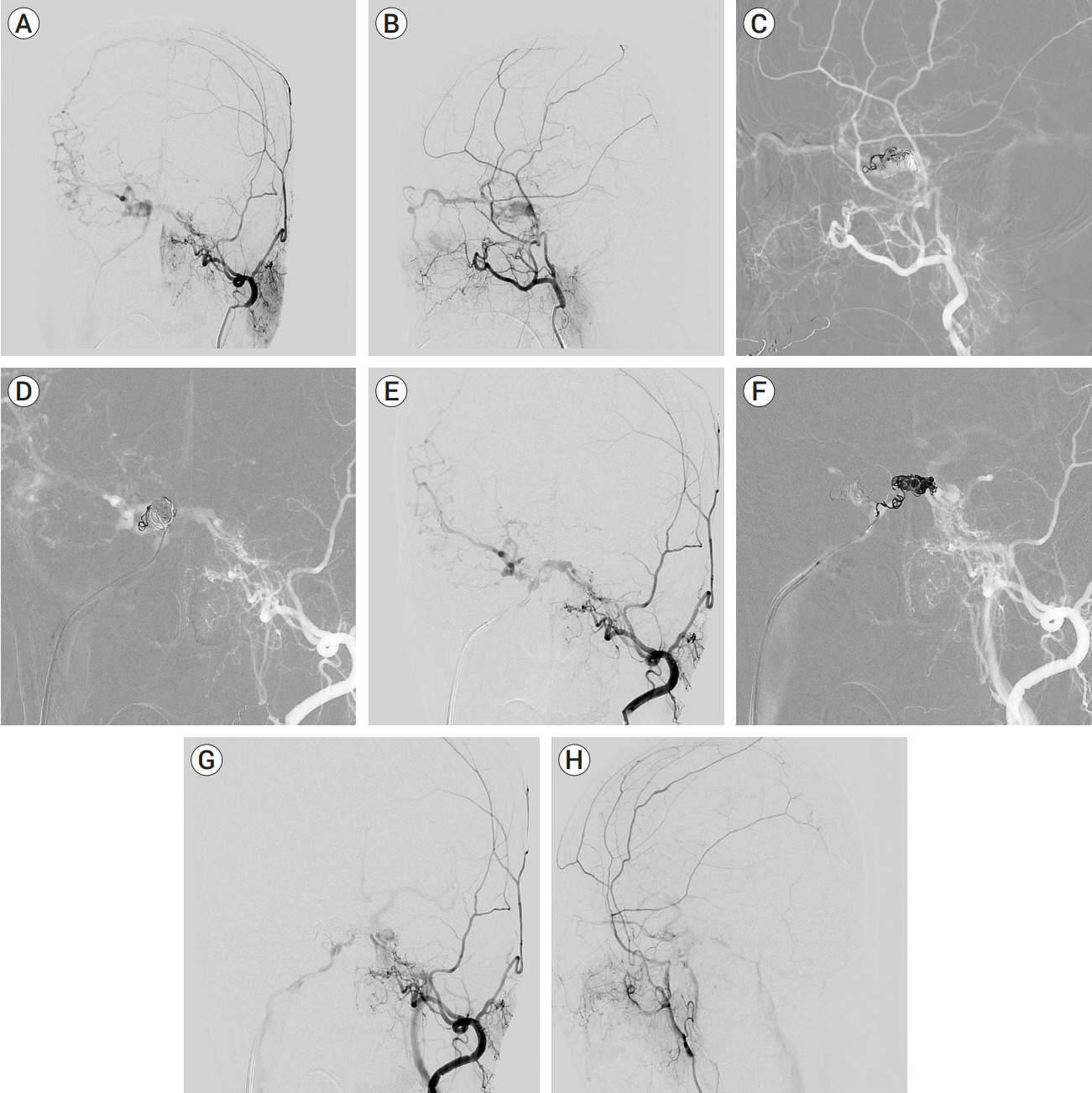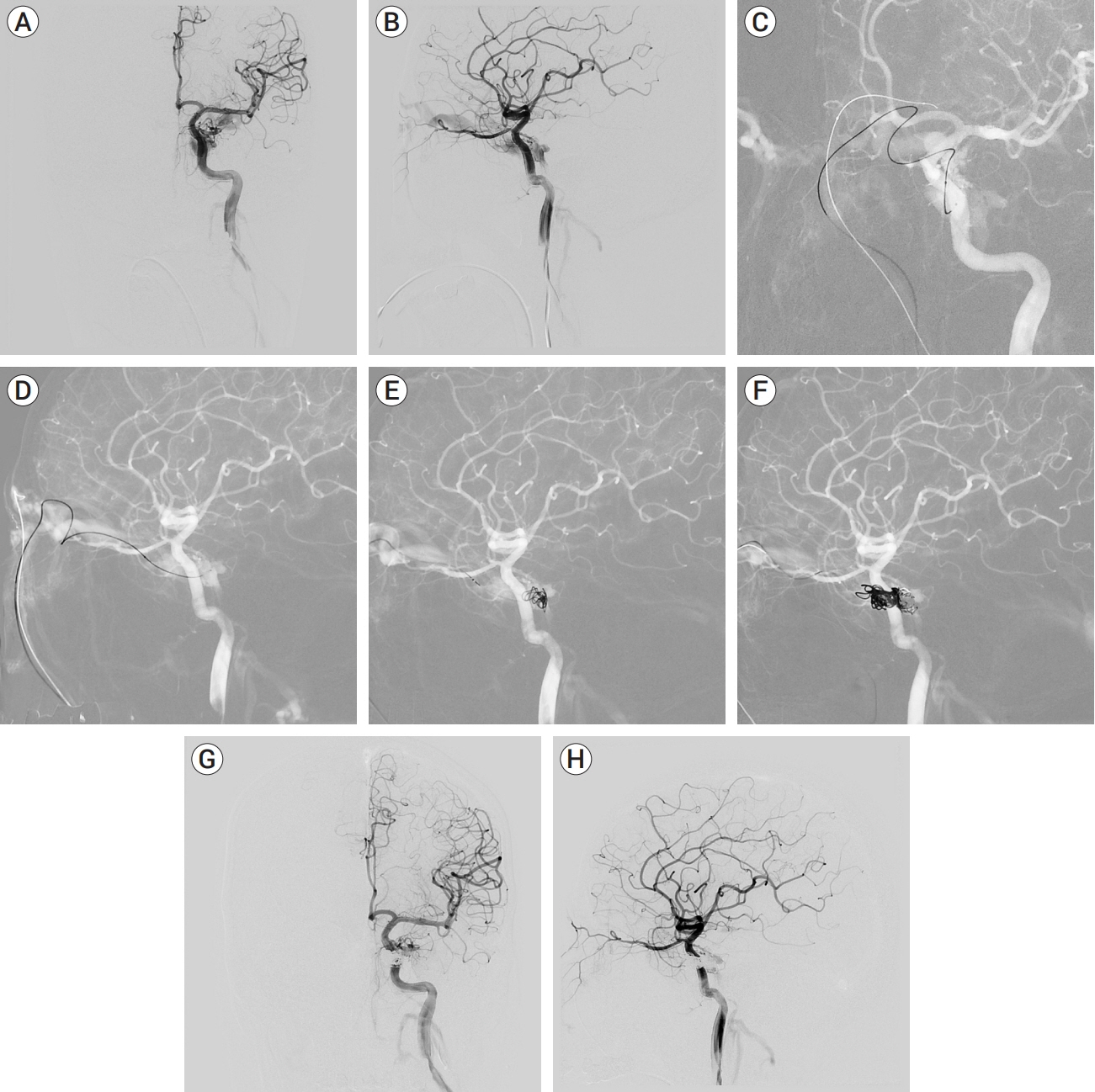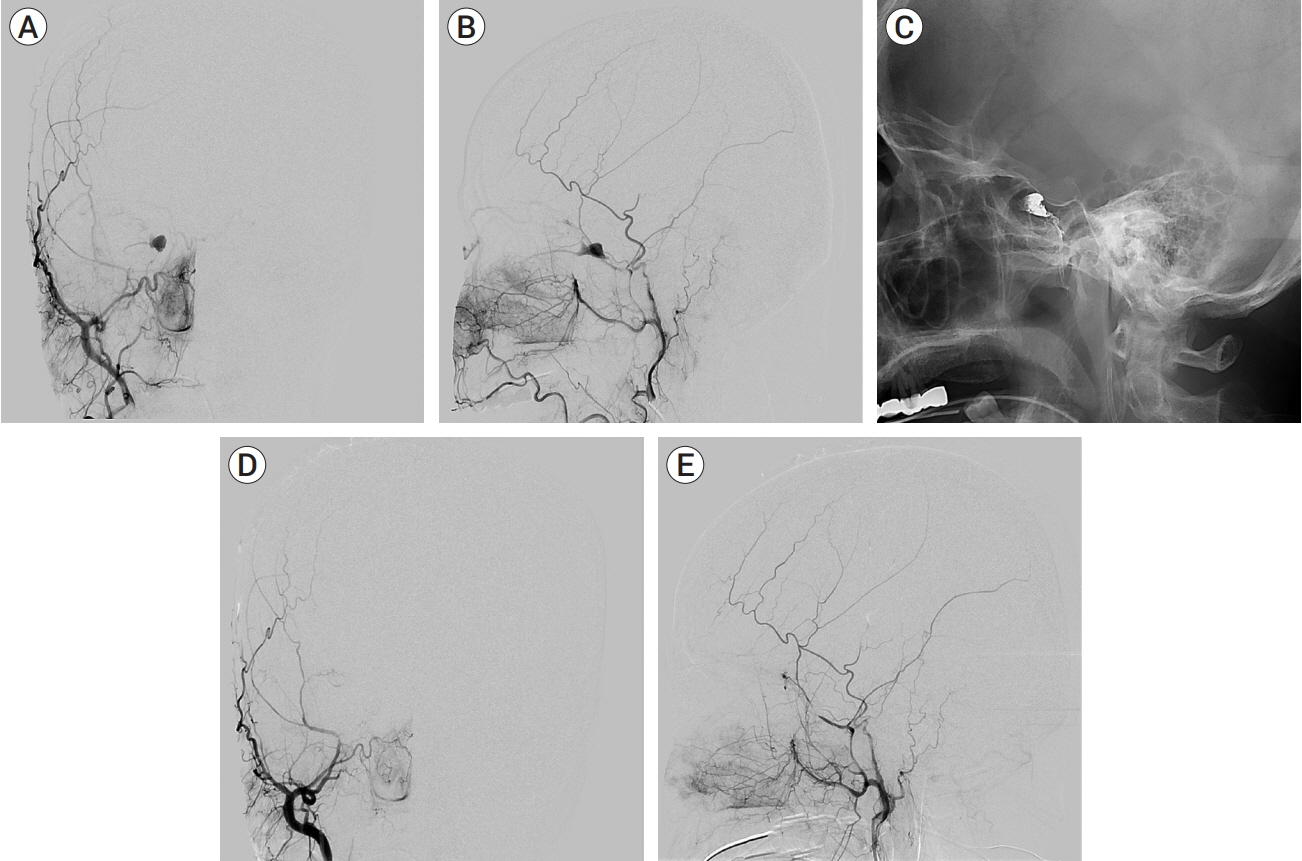J Cerebrovasc Endovasc Neurosurg.
2021 Dec;23(4):293-303. 10.7461/jcen.2021.E2021.04.002.
Endovascular management of cavernous sinus dural arteriovenous fistulas: Overall review and considerations
- Affiliations
-
- 1Department of Neurosurgery, Asan Medical Center, University of Ulsan, College of Medicine, Seoul, Korea
- 2Department of Neurosurgery, Ulsan University Hospital, University of Ulsan College of Medicine, Ulsan, Korea
- KMID: 2523887
- DOI: http://doi.org/10.7461/jcen.2021.E2021.04.002
Abstract
- Cavernous sinus dural arteriovenous fistulas (CSDAVFs) are arteriovenous shunts between small dural branches arising from the external and/or internal carotid arteries and the cavernous sinus (CS). And now a days, endovascular treatment is the treatment of choice in CSDAVF. We review the anatomy and classifications of CSDAVFs, discussing and detailing these considerations in the treatment of CSDAVFs, theoretically and in the light of recent literatures.
Figure
Reference
-
1. Akamatsu Y, Sato K, Endo H, Matsumoto Y, Tominaga T. Single-session hematoma removal and transcranial coil embolization for a cavernous sinus dural arteriovenous fistula: A technical case report. World Neurosurgery. 2017; Aug. 104:1046.
Article2. Barcia-Salorio JL, Soler F, Barcia JA, Hernández G. Stereotactic radiosurgery for the treatment of low-flow carotid-cavernous fistulae: results in a series of 25 cases. Stereotactic and Functional Neurosurgery. 1994; 63(1-4):266–70.
Article3. Barrow D. Cavernous sinus dural arteriovenous malformations. Dural Arteriovenous Malformations. 1993; 117–30.4. Bellon RJ, Liu AY, Adler JR, Norbash AM. Percutaneous transfemoral embolization of an indirect carotid-cavernous fistula with cortical venous access to the cavernous sinus. Journal of Neurosurgery. 1999; May. 90(5):959–63.
Article5. Benndorf G, Campi A. Aberrant inferior petrosal sinus: unusual transvenous approach to the cavernous sinus. Neuroradiology. 2002; Feb. 44(2):158–63.
Article6. Brooks B. Discussion of Noland and Taylor. Trans South Surg Assoc. 1931; 43:176–7.7. Brown JA, Pilitsis JG. Percutaneous balloon compression for the treatment of trigeminal neuralgia: results in 56 patients based on balloon compression pressure monitoring. Neurosurgical Focus. 2005; May. 18(5):E10.
Article8. Chaudhary N, Lownie SP, Bussière M, Pelz DM, Nicolle D. Transcortical venous approach for direct embolization of a cavernous sinus dural arteriovenous fistula: technical case report. Operative Neurosurgery. 2012; Jun. 70(suppl. 2):onsE343–8.
Article9. Cheng KM, Chan CM, Cheung YL. Transvenous embolisation of dural carotid-cavernous fistulas by multiple venous routes: a series of 27 cases. Acta Neurochirurgica. 2003; Jan. 145(1):17–29.
Article10. Cognard C, Gobin YP, Pierot L, Bailly AL, Houdart E, Casasco A, et al. Cerebral dural arteriovenous fistulas: clinical and angiographic correlation with a revised classification of venous drainage. Radiology. 1995; Mar. 194(3):671–80.
Article11. De Andrade GC, Alves H, Parente R, Salvarani CP, Clímaco VM, Pereira ER. Spontaneous isolated dural arteriovenous fistula of the cavernous sinus: endovascular approach via the foramen ovale: A technical note. Interventional Neuroradiology. 2012; Dec. 18(4):458–62.12. Debrun GM, Viñuela F, Fox AJ, Davis KR, Ahn HS. Indications for treatment and classification of 132 carotid-cavernous fistulas. Neurosurgery. 1988; Feb. 22(2):285–9.
Article13. Fioravanti A, Fiaschi P, Badaloni F, Calbucci F. Transcranial approach for surgical-combined-endovascular treatment of a cavernous dural arteriovenous fistula: the superficial sylvian vein route. Journal of Neurosurgical Sciences. 2020; Aug. 64(4):405–7.
Article14. Geibprasert S, Pongpech S, Armstrong D, Krings T. Dangerous extracranial–intracranial anastomoses and supply to the cranial nerves: vessels the neurointerventionalist needs to know. American Journal of Neuroradiology. 2009; Sep. 30(8):1459–68.
Article15. Gemmete JJ, Ansari SA, Gandhi DM. Endovascular techniques for treatment of carotid-cavernous fistula. Journal of Neuro-Ophthalmology. 2009; Mar. 29(1):62–71.16. Gil A, López-Ibor L, Lopez-Flores G, Cuellar H, Murias E, Rodríguez-Boto G. Treatment of a carotid cavernous fistula via direct transovale cavernous sinus puncture. Journal of Neurosurgery. 2013; Jul. 119(1):247–51.17. Guglielmi G, Viñuela F, Briganti F, Duckwiler G. Carotid-cavernous fistula caused by a ruptured intracavernous aneurysm: endovascular treatment by electrothrombosis with detachable coils. Neurosurgery. 1992; Sep. 31(3):591–6.18. Guo WY, Pan DH, Wu HM, Chung WY, Shiau CY, Wang LW, et al. Radiosurgery as a treatment alternative for dural arteriovenous fistulas of the cavernous sinus. American Journal of Neuroradiology. 1998; Jun-Jul. 19(6):1081–7.19. Halbach VV, Higashida RT, Hieshima GB, Hardin CW, Pribram H. Transvenous embolization of dural fistulas involving the cavernous sinus. American Journal of Neuroradiology. 1989; Mar-Apr. 10(2):377–83.20. Hamby WB. Carotid-cavernous fistula: report of 32 surgically treated cases and suggestions for definitive operation. Journal of Neurosurgery. 1964; Oct. 21(10):859–66.21. Higashida RT, Halbach VV, Tsai FY, Norman D, Pribram HF, Mehringer CM, et al. Interventional neurovascular treatment of traumatic carotid and vertebral artery lesions: results in 234 cases. American Journal of Roentgenology. 1989; 153(3):577–82.
Article22. Hosobuchi Y. Electrothrombosis of carotid-cavernous fistula. Journal of Neurosurgery. 1975; Jan. 42(1):76–85.
Article23. Houdart E, Gobin YP, Casasco A, Aymard A, Herbreteau D, Merland JJ. A proposed angiographic classification of intracranial arteriovenous fistulae and malformations. Neuroradiology. 1993; 35(5):381–5.
Article24. Jahan R, Gobin Y, Glenn B, Duckwiler G, Vinuela F. Transvenous embolization of a dural arteriovenous fistula of the cavernous sinus through the contralateral pterygoid plexus. Neuroradiology. 1998; Mar. 40(3):189–93.
Article25. Kirsch M, Henkes H, Liebig T, Weber W, Esser J, Golik S, et al. Endovascular management of dural carotid–cavernous sinus fistulas in 141 patients. Neuroradiology. 2006; Jul. 48(7):486–90.
Article26. Klisch J, Huppertz HJ, Spetzger U, Hetzel A, Seeger W, Schumacher M. Transvenous treatment of carotid cavernous and dural arteriovenous fistulae: results for 31 patients and review of the literature. Neurosurgery. 2003; Oct. 53(4):836–56.
Article27. Kuwayama N, Endo S, Kitabayashi M, Nishijima M, Takaku A. Surgical transvenous embolization of a cortically draining carotid cavernous fistula via a vein of the sylvian fissure. American Journal of Neuroradiology. 1998; Aug. 19(7):1329–32.28. Leibovitch I, Modjtahedi S, Duckwiler GR, Goldberg RA. Lessons learned from difficult or unsuccessful cannulations of the superior ophthalmic vein in the treatment of cavernous sinus dural fistulas. Ophthalmology. 2006; Jul. 113(7):1220–6.
Article29. Lewis AI, Tomsick TA, Tew Jr JM. Management of 100 consecutive direct carotid-cavernous fistulas: results of treatment with detachable balloons. Neurosurgery. 1995; Feb. 36(2):239–44.30. Li MH, Tan HQ, Fang C, Zhu YQ, Wang W, Wang J, et al. Trans-arterial embolisation therapy of dural carotid–cavernous fistulae using low concentration n-butyl-cyanoacrylate. Acta Neurochirurgica. 2008; Nov. 150(11):1149–56.
Article31. Matsumoto A, Okauchi M, Shindo A, Kawanishi M, Tamiya T. Cavernous sinus dural arteriovenous fistula treated by facial vein direct puncture: Case report and review of the literature. Interventional Neuroradiology. 2017; Jun. 23(3):301–6.
Article32. Meyers PM, Halbach VV, Dowd CF, Lempert TE, Malek AM, Phatouros CC, et al. Dural carotid cavernous fistula: definitive endovascular management and long-term follow-up. American journal of ophthalmology. 2002; Jul. 134(1):85–92.
Article33. Michels KS, Ng JD, Falardeau J, Roberts WG, Petersen B, Nesbit GM, et al. Transvenous embolization of a dural carotid-cavernous sinus fistula via the inferior ophthalmic vein. Ophthalmic Plastic & Reconstructive Surgery. 2007; Nov-Dec. 23(6):480–2.
Article34. Mullan S. Treatment of carotid-cavernous fistulas by cavernous sinus occlusion. Journal of Neurosurgery. 1979; Feb. 50(2):131–44.
Article35. Nelson PK, Russell SM, Woo HH, Alastra AJ, Vidovich DV. Use of a wedged microcatheter for curative transarterial embolization of complex intracranial dural arteriovenous fistulas: indications, endovascular technique, and outcome in 21 patients. Journal of Neurosurgery. 2003; Mar. 98(3):498–506.
Article36. Parkinson D. A surgical approach to the cavernous portion of the carotid artery: anatomical studies and case report. Journal of Neurosurgery. 1965; Nov. 23(5):474–83.37. Parkinson D. Lateral sellar compartment O.T. (cavernous sinus): history, anatomy, terminology. The Anatomical Record. 1998; Aug. 251(4):486–90.
Article38. Parkinson D. Transcavernous repair of carotid cavernous fistula: case report. Journal of Neurosurgery. 1967; Apr. 26(4):420–4.39. Peeters FL, Kroger R. Dural and direct cavernous sinus fistulas. American Journal of Roentgenology. 1979; 132(4):599–606.
Article40. Pollock BE, Nichols DA, Garrity JA, Gorman DA, Stafford SL. Stereotactic radiosurgery and particulate embolization for cavernous sinus dural arteriovenous fistulae. Neurosurgery. 1999; Sep. 45(3):459–66.
Article41. Satomi J, Satoh K, Matsubara S, Nakajima N, Nagahiro S. Angiographic changes in venous drainage of cavernous sinus dural arteriovenous fistulae after palliative transarterial embolization or observational management: a proposed stage classification. Neurosurgery. 2005; Mar. 56(3):494–502.
Article42. Serbinenko FA. Balloon catheterization and occlusion of major cerebral vessels. Journal of Neurosurgery. 1974; Aug. 41(2):125–45.
Article43. Shi ZS, Qi TW, Gonzalez NR, Ziegler J, Huang ZS. Combined covered stent and onyx treatment for complex dural arteriovenous fistula involving the clivus and cavernous sinus. Surgical Neurology. 2009; Aug. 72(2):169–74.
Article44. Stiebel-Kalish H, Setton A, Nimii Y, Kalish Y, Hartman J, BarOn RH, et al. Cavernous sinus dural arteriovenous malformations: patterns of venous drainage are related to clinical signs and symptoms. Ophthalmology. 2002; Sep. 109(9):1685–91.
Article45. Suh DC, Lee JH, Kim SJ, Chung SJ, Choi CG, Kim HJ, et al. New concept in cavernous sinus dural arteriovenous fistula: correlation with presenting symptom and venous drainage patterns. Stroke. 2005; Jun. 36(6):1134–9.46. Takahashi M, Tanaka M. Cavernous sinus venography by transfemoral catheter technique. Neuroradiology. 1971; Nov. 3(1):1–3.
Article47. Thomas AJ, Chua M, Fusco M, Ogilvy CS, Tubbs RS, Harrigan MR, et al. Proposal of venous drainage–based classification system for carotid cavernous fistulae with validity assessment in a multicenter cohort. Neurosurgery. 2015; Sep. 77(3):380–5.
Article48. Travers B. A case of aneurism by anastomosis in the orbit, cured by the ligature of the common carotid artery. Medico-Chirurgical Transactions. 1811; 2:1–420. 1.49. Venturi C, Bracco S, Cerase A, Gennari P, Lorè F, Polito E, et al. Endovascular treatment of a cavernous sinus dural arteriovenous fistula by transvenous embolisation through the superior ophthalmic vein via cannulation of a frontal vein. Neuroradiology. 2003; Aug. 45(8):574–8.
Article50. Wakhloo AK, Perlow A, Linfante I, Sandhu JS, Cameron J, Troffkin N, et al. Transvenous n-butyl-cyanoacrylate infusion for complex dural carotid cavernous fistulas: technical considerations and clinical outcome. American Journal of Neuroradiology. 2005; Sep. 26(8):1888–97.51. Wenderoth J. Proposal for an improved classification system for cavernous sinus dural arteriovenous fistula (CS-DAVF). Journal of Neurointerventional Surgery. 2017; Mar. 9(3):220–4.
Article52. Yu SC, Cheng HK, Wong GK, Chan CM, Cheung JY, Poon WS. Transvenous embolization of dural carotid-cavernous fistulae with transfacial catheterization through the superior ophthalmic vein. Neurosurgery. 2007; Jun. 60(6):1032–7.
Article
- Full Text Links
- Actions
-
Cited
- CITED
-
- Close
- Share
- Similar articles
-
- Middle temporal vein access for transvenous embolization of Cavernous sinus dural arteriovenous fistula: A case report and review of literature
- Transvenous Coil Embolization for Dural Arteriovenous Fistulas of the Ophthalmic Sheath: Report of Two Cases and Review of the Literature
- Superior ophthalmic approach in carotid-cavernous fistula: current concepts in indications, surgical techniques, and case reviews
- Transvenous Embolization of Cavernous Sinus Dural Arteriovenous Fistula Using the Direct Superior Ophthalmic Vein Approach: A Case Report
- Endovascular Treatment of Cavernous Sinus Dural Arteriovenous Fistula via Radial Artery and Median Cubital Vein




